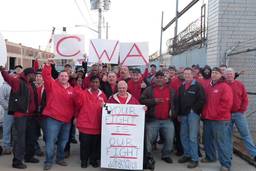On Thursday evening, President Obama’s Deputy Campaign Manager Stephanie Cutter tweeted out a link that made it seem like she was bragging about how the Obama administration has taken on teachers unions. Cutter tweeted out a link to a Washington Post article saying “FACT CHECK: Romney off on Obama’s relationship with teachers’ unions; it’s anything but cozy: http://wapo.st/Lu0nYZ” . The article went on to describe how the Obama administration has taken on teachers unions:
Obama has promoted initiatives that encourage districts to tie teacher evaluations to student performance and to expand the number of charter schools — actions the teacher unions have long been against, and which Romney himself promoted Wednesday in a speech in Washington outlining his education platform […]
At its annual meeting last year, the National Education Association, the country’s largest teachers union, sent a message to Obama that it was “appalled” with Education Secretary Arne Duncan’s practice of focusing heavily on charter schools, supporting decisions to fire all staff and using high-stakes standardized test scores for teacher evaluations, along with 10 other policies mentioned.
“Obama has taken on teachers unions unlike any previous Democratic president,” said Tom Loveless of the Brookings Institution. “Because of that his support among union members, although it is still there, is rather tepid.”
Union supporters were outraged by the comments, with American Federation of Teachers President Randi Weingarten tweeting out “@stefcutter -are you kidding me? More & more Electeds know when they work w/ the @AFTunion -students win-look at Cleveland and New Haven”. Cutter (@stefcutter) later walked back the remarks on twitter, saying “Pres. fights for unions/teachers b/c he believes in them-Mitt dishonest about being beholden to them”
A new investigate report released by ProPublica and PBS Frontline shows that men who climb cellphone towers die in workplace accidents at ten times the rate of construction workers. The study shows that more workers employed as subcontractors were killed working on AT&T projects than all three of AT&T’s biggest competitors combined. The article suggests that a high number of cell tower climbers died as a result of AT&T’s merger with Cingular and its attempt to expand iPhone coverage:
The death toll peaked between 2006 and 2008, as AT&T merged its network with Cingular’s and scrambled to handle traffic generated by the iPhone. Eleven climbers died on AT&T jobs in those three years, including Guilford.
“I don’t think there’s any question that the pressure to build out the network has been a contributing factor to fatalities,” said Steve Watts, who worked as a risk manager at AT&T until 2007.
While there has been much attention to workers killed and injured at Foxconn factories, it appears that Steve Jobs put pressure on AT&T to build cell towers more rapidly than AT&T initially thought feasible:
The pressure ratcheted up again when AT&T became the exclusive carrier for the iPhone.
After the phone debuted in summer 2007, triggering a tsunami of data usage, customers began complaining about dropped calls and spotty service. According to a report in Wired, AT&T went to Apple, asking for help in limiting traffic to buy time for tower upgrades. Instead, Apple Chief Executive Steve Jobs explored switching to Verizon, the report said.
To prepare for the iPhone 3G’s introduction in summer 2008, AT&T poured billions of dollars into wireless capital expenditures. The push meant work on an unprecedented scale for tower climbers.
“It was nuts,” said Dan MacRae, a project manager who has worked on cell site projects for several turf vendors. “We were working in the field for 40 hours straight. They had crews in rain, sleet, snow.”
The building boom was accompanied by a string of accidents.
After two climbers died on AT&T jobs within a five-day period in April 2008, the carrier sent a letter to turf vendors calling for a construction stand down to discuss safety procedures and hold half-day courses to retrain workers.
But Guilford died just three and a half weeks after the work stoppage. Two more climbers died on AT&T jobs within the next four months.
A new study in Science Magazine finds that OSHA workplace safety regulations actually save companies big money. According to a blog post put out by OSHA Administrator David Michaels:
The study, “Randomized Government Safety Inspections Reduce Worker Injuries with no Detectable Job Loss,” found that workplace injury claims dropped 9.4% at randomly chosen businesses in the four years following an inspection by the California OSHA program, compared with employers not inspected. Those same employers also saved an average of 26% on workers’ compensation costs, when compared with similar firms that were not inspected. This means that the average employer saved $355,000 (in 2011 dollars) as a result of an OSHA inspection. The effects were seen among small and large employers.
Translated to the nation as a whole, OSHA inspections prevent thousands of workplace injuries, while saving employers money and protecting jobs. Michael Toffel, Associate Professor of Business Administration at the Harvard Business School, estimates that OSHA inspections nationwide could be saving employers $6 billion. And this doesn’t count the costs of lost production when workers are injured or made sick by their jobs or the pain and suffering of employees that is not compensated.
Prison Guards in North Las Vegas, Nevada this week went on an illegal “sick-out” strike to protest layoffs:
Forty-nine workers at the jail called in sick, causing significant problems staffing the facility. Jail officials submitted a list of inmates that were deemed safe for release and a judge signed off on it earlier this week.
According to a police spokesman, the jail was planning to release a certain number of inmates to plug an $18 million budget hole. However, rumors began to surface that layoffs were coming, and nearly 50 workers called out sick.
Because of the lack of staff, officials went to a judge to get an emergency order to release the inmates. They say they had to release the inmates because they did not feel they could safely staff the facility.
113 Allied/Republic Waste workers voted to join the Teamsters this week. According to the Teamsters:
Sanitation workers at Allied Waste in Fall River, Mass. voted this morning to join Teamsters Local 251 in East Providence, RI. The 113 employees in the bargaining unit work as commercial drivers, residential drivers, and shakers. View more photos.
“We are happy that these dedicated workers chose to be represented by the Teamsters Union,” said Joe Bairos, Secretary-Treasurer of Local 251. “Sanitation work is one of the most dangerous jobs in America, and they deserve the protections of a contract. We look forward to improving their working conditions.”
“My co-workers and I work hard and have been serving our communities for years,” said Marco Madeiros, a 20-year front-load driver at Allied/Republic.” Some of us have been here 20, 30 years. We had enough of the bullying and favoritism, so we chose to organize and form a union to negotiate with the company as a group.”








